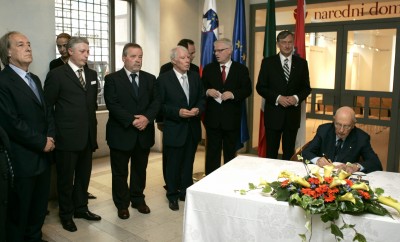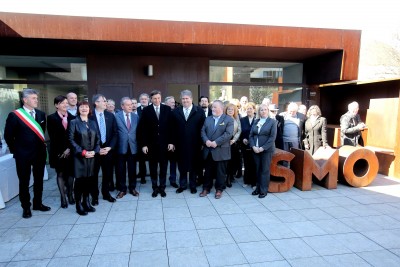
ORIGINS
The Slovene minority in Italy lives in the Friuli Venezia Giulia region in the three provinces bordering Slovenia: Trieste (Trst), Gorizia (Gorica) and Udine (Videm). Slav ancestors settled in the area where Slovenes are present today at the end of the 6th century CE, after moving from the Danube-Balkan region into the area within present-day Slovenia and the neighbouring territory including the Italian border strip, which stretches from Muggia (Milje) to Tarvisio (Trbiž) and is about 30 kilometres wide. The Slovene settlement area in Italy is divided into six rather self-contained units: the Trieste (Trst) area, the Gorizia (Gorica) area, the Natisone (Nadiža) Valleys, the Torre (Terska) valley, the Resia (Rezija) and Canale (Kanalska) Valleys. This division is a result of several different natural-geographical, historical, socio-cultural, economic and political factors affecting the aforementioned areas, which are populated by communities whose members are the expression of Slovene language and culture. The formal demarcation of the territory where protective measures are enforced under the 28/2001 Minority Protection Law comprises 32 municipalities in all three Provinces. The legal protection of the Slovene minority is based on international laws and regulations, namely the Italian Constitution, the Framework Convention for the Protection of National Minorities, the London Memorandum, the Treaty of Osimo, the Slovene Minority Protection Law no. 38/2001, the Friuli Venezia Giulia Regional Law no. 26/2007 and more.

TERRITORY
The Slovene national community is actively involved in the administration of the territory. SKGZ and SSO, the community’s two umbrella organisations – the expression of civil society with over 300 member associations – are the main interlocutors between the community and the national, regional and local authorities in Italy and Slovenia. On the political front, Slovenes in Italy are affiliated in different parties, including the only catch-all party Slovenska skupnost, which strives for independent political representation. From the administration perspective, the Slovene presence is reflected in the activities of the Institutional Joint Committee on matters regarding the Slovene minority (Friuli Venezia Giulia), the Commission of the National Assembly of the Republic of Slovenia for Relations with Slovenes in Neighbouring and Other Countries, of the Institutional Roundtable for the Slovene minority at the Italian Ministry for Internal Affairs, the Slovenian Government Council for Slovenes in Neighbouring Countries, the Regional Consultative Commission on the Slovene minority (Friuli Venezia Giulia) as well as other bodies.


DIMENZIJE IN ZASTOPANJE
Manjšina je vsestransko razvita na področju kulture, izobraževanja, raziskovalne dejavnosti, športa in rekreacije, glasbe, gospodarstva in sociale. Poleg Slovenskega stalnega gledališča v Trstu (ustanovljeno 1902) s sedežem v Kulturnem domu, ima manjšina dve glasbeni šoli: Glasbena matica (u. 1909) in SCGV Emil Komel (u. 1953), Kulturni center Lojze Bratuž in Kulturni dom – oba v Gorici, Center SMO v Špetru in vrsto drugih kulturnih organizacij (ZSKD/Zveza slovenskih kulturnih društev, ZSKP/Zveza slovenske katoliške prosvete, SP/Slovenska prosveta). Športna društva pa so vključena v ZSŠDI/Združenje slovenskih športnih društev v Italiji. Na medijskem področju deluje v okviru deželnega sedeža RAI v Trstu slovenska postaja RAI Radio TS A (u. 1944), ki oddaja televizijske in radijske programe v slovenščini. Na področju tiskanih medijev izhajajo: 1 dnevnik (Primorski dnevnik, u. 1945), 2 tednika (Novi glas (u. 1949) in Novi Matajur (u. 1950)) in 1 petnajstdnevnik (Dom, u. 1965) ter deluje 5 knjižnih založb. Na gospodarskem področju SDGZ (Slovensko deželno gospodarsko združenje) združuje slovenska podjetja in obrtnike v deželi FJK, medtem ko opravlja to vlogo na področju kmetijstva Deželna kmečka zveza.
Na območju pokrajin Trst in Gorica obstaja danes razvejana mreža državnih šol s slovenskim učnim jezikom za celoten izobraževalni cikel: vrtci, osnovne šole, srednje šole prve in druge stopnje. V teh šolah poteka pouk – z izjemo ur italijanskega in ostalih tujih jezikov – v slovenščini, in sicer v skladu z ministrskimi smernicami, ki veljajo tudi za šole z italijanskim učnim jezikom. Na Videmskem pa deluje večstopenjska šola s slovensko-italijanskim dvojezičnim poukom v Špetru. Italijansko ministrstvo za šolstvo je leta 2018 izrecno potrdilo možnost poučevanja slovenščine kot drugega evropskega jezika, kar olajšuje postopke za uvajanje pouka slovenščine v šole z italijanskim učnim jezikom.
Slovenska manjšina je dinamična in dobro organizirana skupnost, ki predstavlja dodano vrednost za čezmejno območje in za celotno deželo FJK.

LINK
www.skgz.org/
www.ssorg.eu/
www.zskd.eu
www.zskpgo.eu
http://slovenskaprosveta.org/
www.mismotu.it
www.knjiznica.it
www.glasbenamatica.org
www.emilkomel.eu
www.sdgz.it
www.zssdi.it
www.kmeckazveza.com
www.primorski.it
www.slori.org
www.teaterssg.com
DRUGI VIRI
Mi, Slovenci v Italiji / Noi, sloveni in Italia / We, the Slovenes in Italy, AA:VV., edito da SKGZ ed SSO, Trieste-Gorizia 2018